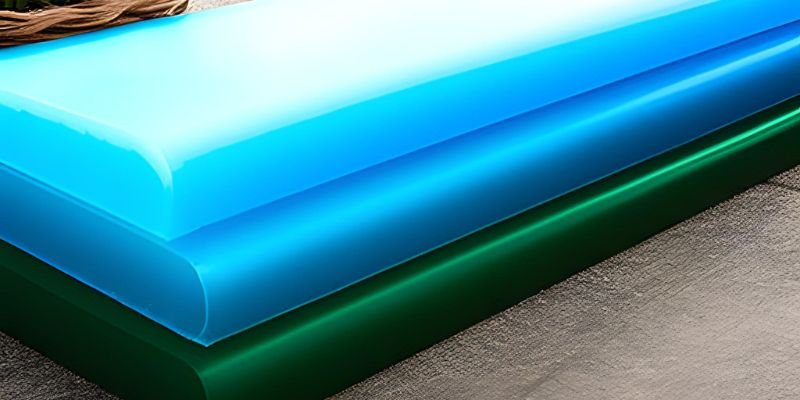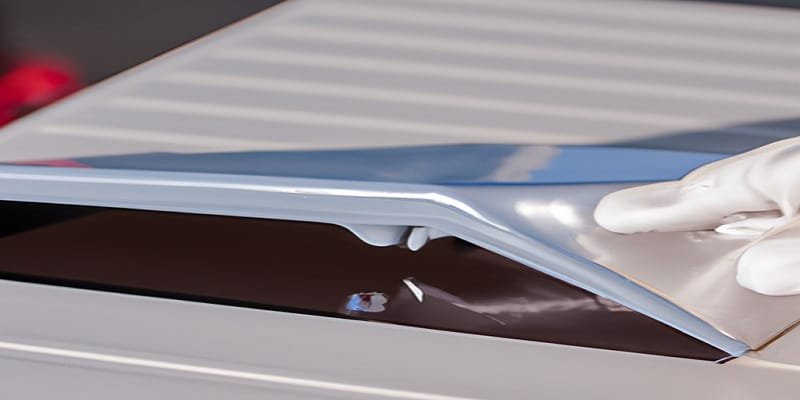We use a powder coating process to create a protective layer on HDPE (High Density Polyethylene) material. This process involves electrostatically spraying a dry powder onto the surface of the material, which is then cured in an oven to create a tough, durable coating.
The powder coating process offers several advantages over traditional liquid coating methods. For one, it creates a more uniform coating thickness, which helps to ensure consistent performance and appearance. Additionally, powder coating is more environmentally friendly, as it produces less waste and emits fewer volatile organic compounds (VOCs) than liquid coatings.

HDPE Material Powder Coating Process
To ensure the best possible results, we take several steps to prepare the HDPE material before powder coating. First, we thoroughly clean and dry the surface to remove any dirt, oil, or other contaminants. Next, we apply a pre-treatment solution to help the powder coating adhere to the material. Finally, we carefully apply the powder coating using specialized equipment to ensure an even, consistent coating.
Overall, we have found that the powder coating process is an excellent choice for protecting HDPE material from damage and wear. Its durability, uniformity, and environmental benefits make it a highly effective and sustainable solution for a wide range of applications.
Preparation of HDPE for Powder Coating
Cleaning
Before powder coating HDPE, it is essential to clean the surface thoroughly. We use a mixture of water and mild detergent to remove any dirt, dust, or other contaminants from the surface. We apply the cleaning solution using a soft-bristled brush or a sponge and then rinse the surface with clean water. After cleaning, we let the surface dry completely before proceeding to the next step.
Degreasing
HDPE surfaces often have traces of oils or greases, which can interfere with the adhesion of the powder coating. Therefore, we degrease the surface using a solvent-based cleaner. We apply the degreaser using a clean cloth or a spray bottle and let it sit for a few minutes. Then, we wipe off the degreaser with a clean, dry cloth. We repeat the process if necessary until the surface is completely free of oils or greases.
Abrading
To ensure good adhesion of the powder coating, we roughen the surface using abrasives. We use sandpaper or a sandblasting machine to create a profile on the surface. The profile provides a mechanical bond between the HDPE and the powder coating. We choose the abrasives depending on the type and thickness of the HDPE and the desired finish. After abrading, we clean the surface again to remove any dust or debris.
In conclusion, preparing HDPE for powder coating requires thorough cleaning, degreasing, and abrading. These steps ensure that the powder coating adheres well to the HDPE and provides a durable finish.
Powder Application on HDPE
To apply powder coating on HDPE material, we follow a specific process. First, we ensure that the HDPE material is clean and free of any dust or debris. We use a cleaning solution to remove any contaminants from the surface of the material.
Next, we preheat the material to a specific temperature. The temperature depends on the type of powder being used and the thickness of the material. Preheating the material helps to create a smooth and even surface for the powder to adhere to.
Once the material is preheated, we use an electrostatic spray gun to apply the powder coating. The spray gun charges the powder particles, which are then attracted to the grounded HDPE material. This creates a strong bond between the powder and the material.
After the powder is applied, we cure the material in an oven. The curing process involves heating the material to a specific temperature for a set amount of time. This process allows the powder to melt and flow together, creating a durable and long-lasting finish.
Overall, the powder application process on HDPE is a reliable and effective way to create a high-quality finish on the material. By following a specific process and using the right equipment and materials, we can ensure that the powder coating will adhere properly and provide excellent protection against wear and tear.
Curing Process for HDPE
After the HDPE material has been powder coated, it needs to go through a curing process to ensure that the coating is properly bonded to the surface of the material. The curing process for HDPE involves heating the coated material to a specific temperature for a set amount of time.
At our facility, we use a conveyor oven to cure our HDPE powder coated materials. The oven is set to a temperature of 400°F and the coated material is passed through the oven for 15 minutes. This ensures that the coating is fully cured and bonded to the surface of the material.
During the curing process, it is important to monitor the temperature and time to ensure that the material is not overheated or undercured. Overheating can cause the coating to bubble or peel, while undercuring can result in a weak bond between the coating and the material.
To ensure that our HDPE powder coated materials are properly cured, we use a temperature monitoring system that tracks the temperature of the material as it passes through the oven. This allows us to make adjustments to the oven temperature or conveyor speed as needed to ensure that the curing process is consistent and effective.
Overall, the curing process is a critical step in the powder coating process for HDPE materials. By carefully monitoring the temperature and time, we can ensure that our coatings are properly cured and provide long-lasting protection for our customers’ products.
Quality Control and Testing
At our facility, we take quality control and testing very seriously to ensure that the HDPE material powder coated process meets the highest standards. We have a dedicated team that carries out various tests to ensure the quality of our products.
Adhesion Testing
One of the most important tests we perform is adhesion testing. This test ensures that the powder coating adheres properly to the HDPE material. We use a cross-cut adhesion test to check the adhesion of the coating. This involves cutting a grid pattern on the surface of the coated material and then applying a piece of tape over the grid. We then pull the tape off to see if any of the coating comes off with it. If the coating comes off, it indicates poor adhesion, and we reject the material.
Impact Resistance Testing
Another important test we perform is impact resistance testing. This test determines how well the coating can withstand impacts without cracking or chipping. We use a drop impact test to measure the impact resistance of the coating. This involves dropping a heavy weight onto the coated material from a specified height and then examining the coating for any damage. If the coating shows signs of cracking or chipping, it fails the test, and we reject the material.
We also perform other tests, such as gloss and color testing, to ensure that the finished product meets the required specifications. Our quality control and testing procedures ensure that our customers receive the highest quality HDPE material powder coated products.
Advantages of Powder Coating on HDPE
Durability
Powder coating provides excellent durability and resistance to chipping, scratching, and fading, making it ideal for HDPE (High-Density Polyethylene) materials. The coating forms a protective layer that enhances the lifespan of HDPE products, ensuring they can withstand harsh environmental conditions.
Versatility
Powder coating offers a wide range of color options and finishes, allowing for greater customization and aesthetic appeal. It can be applied to HDPE in various thicknesses, textures, and patterns, enabling manufacturers to achieve different visual effects and surface characteristics.
Environmental Friendliness
Powder coating is a more environmentally friendly option compared to traditional liquid coatings. It doesn’t contain solvents or emit volatile organic compounds (VOCs), reducing air pollution and health risks. Additionally, any overspray from the powder coating process can be collected and reused, minimizing waste.
Cost-effectiveness
Powder coating can be a cost-effective choice for HDPE applications. The process is highly efficient, with little to no material wastage, and offers high transfer rates. Additionally, the durability of powder-coated HDPE reduces the need for frequent maintenance or replacement, saving costs in the long run.
Challenges and Solutions in HDPE Powder Coating
Adhesion
HDPE surfaces can be challenging to coat due to their low surface energy. Ensuring proper adhesion of the powder coating requires surface preparation techniques such as flame treatment or corona discharge treatment to enhance surface energy and promote adhesion.
Melt Temperature
HDPE has a lower melting point compared to other thermoplastic materials, which can be a challenge during the powder coating process. The high curing temperatures required for powder coating may lead to deformation or warping of the HDPE. One solution is to use specially formulated powder coatings with lower curing temperatures to mitigate this issue.
Thickness Control
Achieving consistent and uniform coating thickness on HDPE can be challenging due to its non-conductive nature. This can result in uneven powder distribution and varying coating thicknesses. Implementing proper grounding and utilizing advanced powder coating equipment, such as electrostatic guns with adjustable settings, can help achieve more precise and uniform coating thickness.
Applications of Powder Coated HDPE
Outdoor Furniture
Powder-coated HDPE is commonly used for outdoor furniture, such as chairs, tables, and benches. The coating provides protection against weathering, UV radiation, and corrosion, ensuring the furniture retains its appearance and durability over time.
Playground equipment:
HDPE powder coating is ideal for coating playground equipment like slides, swing sets, and climbing structures. The coating enhances the surface’s safety and longevity, making it resistant to scratches, abrasions, and fading, while also providing an attractive finish.
Industrial Applications
Powder-coated HDPE finds applications in various industrial settings. It is used to coat storage containers, tanks, and pipes, providing protection against chemical corrosion and extending the lifespan of these assets.
Automotive Components
HDPE powder coating is utilized for automotive components such as bumper covers, wheel arches, and trim. The coating improves impact resistance, protects against environmental elements, and contributes to the overall aesthetic appeal of the vehicle.
Retail Displays and Signage
Powder-coated HDPE is often employed in retail displays, signage, and point-of-sale fixtures. The coating offers durability, easy maintenance, and a wide range of color options, enabling businesses to create eye-catching and long-lasting marketing materials.
Overall, the advantages of powder coating on HDPE, coupled with solutions to overcome challenges, make it a viable option for a variety of applications, ranging from outdoor furniture and playground equipment to industrial and automotive components.


